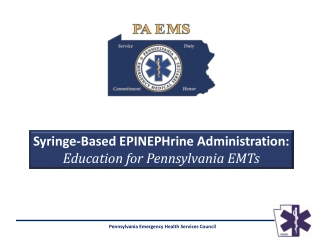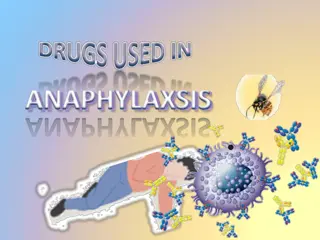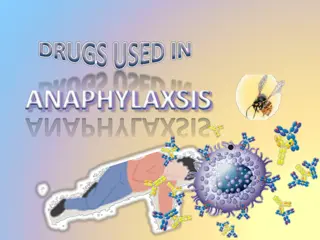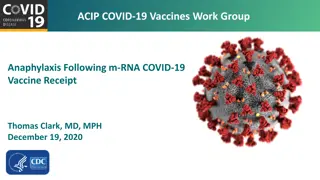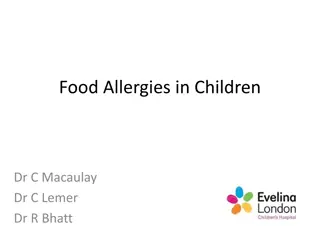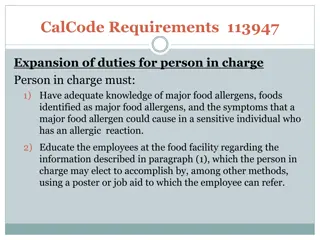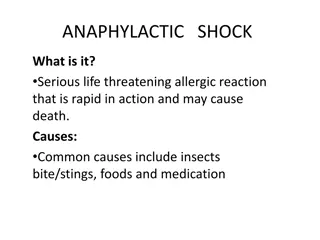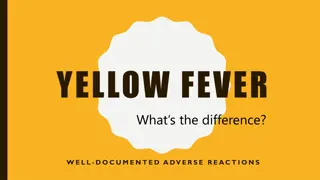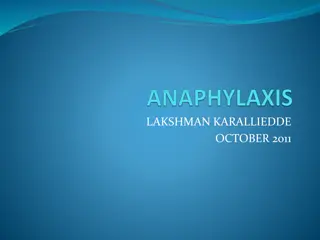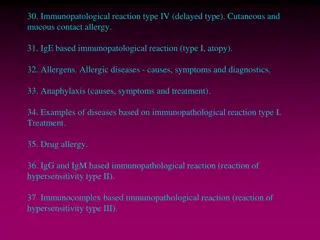Syringe-Based EPINEPHrine Administration Education in Pennsylvania
The Pennsylvania Emergency Health Services Council is promoting syringe-based EPINEPHrine administration for EMTs as a cost-effective and safe alternative to auto-injectors. This initiative aims to educate on anaphylaxis pathophysiology, EPINEPHrine pharmacology, and safe medication practices while
0 views • 34 slides
Emergency Drugs and Their Mechanisms of Action
Learn about essential emergency drugs such as Adrenaline, Adenosine, Atropine, Furosemide, Calcium Gluconate, and Lidocaine. Understand their mechanisms of action, dosages, indications, and onset times to effectively manage cardiac arrest, anaphylaxis, arrhythmias, and other critical conditions.
3 views • 17 slides
Understanding Anaphylaxis: Symptoms, Management, and Classification
Anaphylaxis is a severe allergic reaction that can be life-threatening if not managed promptly. It manifests with symptoms like rash, mucosal swelling, difficulty breathing, and reduced blood pressure. This reaction is classified as anaphylactic shock, a type of shock involving circulatory and organ
0 views • 18 slides
Understanding Anaphylaxis and Anaphylactic Shock
Anaphylaxis is a severe allergic reaction affecting the entire body, while anaphylactic shock is a life-threatening manifestation of this reaction involving shock and airway swelling. This comprehensive material delves into the nature, causes, symptoms, diagnostic features, emergency management prot
0 views • 18 slides
Recent Developments in Anaphylaxis Following COVID-19 Vaccination
Various reports and guidelines regarding anaphylaxis following COVID-19 vaccination have emerged, including cases in the UK and US, CDC actions, and ACIP considerations. The CDC has highlighted the importance of recognizing and managing anaphylactic reactions, with close collaboration with various a
0 views • 8 slides
Understanding Food Allergies in Children
Food allergies in children can be IgE-mediated or non-IgE-mediated reactions, with common allergens including fish, eggs, peanuts, and more. The prevalence of food allergies in Europe and North America ranges from 6% to 8% in children up to 3 years old. Symptoms may vary from immediate reactions lik
0 views • 11 slides
Understanding Major Food Allergens and Anaphylaxis
Major food allergens, including milk, eggs, fish, shellfish, tree nuts, wheat, peanuts, and soybeans, can cause severe allergic reactions in sensitive individuals. Symptoms of food allergies range from mild to life-threatening, with anaphylactic shock being a serious complication that requires immed
0 views • 8 slides
Understanding Anaphylactic Shock: Causes, Symptoms, and Treatment
Anaphylactic shock is a serious, life-threatening allergic reaction that can rapidly escalate and potentially lead to death. Common triggers include insect bites or stings, foods, and medications. Symptoms range from skin itchiness and hives to respiratory difficulties and cardiac issues. Proper dia
0 views • 11 slides
Yellow Fever: Adverse Reactions and Risks
Yellow fever vaccination can lead to severe adverse reactions like anaphylaxis, neurotropic disease, and viscerotropic disease. These reactions can range from immediate hypersensitivity to rare but serious outcomes such as meningitis and multiple system organ failure. The mortality rate associated w
0 views • 11 slides
Understanding Anaphylaxis: Symptoms, Signs, and Treatment
Anaphylaxis is a severe, life-threatening allergic reaction that can occur in response to various allergens. It manifests rapidly with symptoms like difficulty breathing, abdominal pain, skin reactions, and more. Early recognition of symptoms and prompt treatment with adrenaline are crucial for mana
0 views • 23 slides
Understanding Immunopathological Reactions and Autoimmune Diseases
Discover the classification of immunopathological reactions by Gell and Coombs, including Type I to IV reactions, with insights into allergic diseases, anaphylaxis, drug allergy, and autoimmune diseases like Graves' disease and Myasthenia gravis.
0 views • 51 slides
